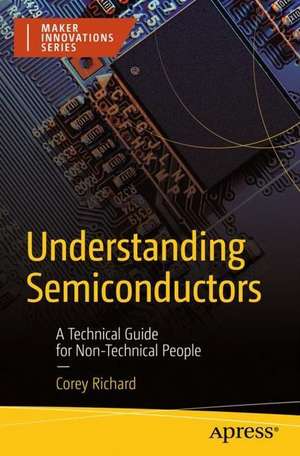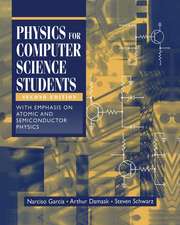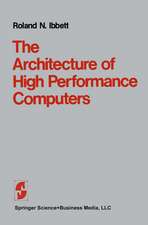Understanding Semiconductors: A Technical Guide for Non-Technical People: Maker Innovations Series
Autor Corey Richarden Limba Engleză Paperback – 30 dec 2022
Melding an accessible, conversational style with over 100 diagrams and illustrations, Understanding Semiconductors provides clear explanations of technical concepts going deep enough to fully explain key vernacular, mechanisms, and basic processes, without getting lost in the supporting theories or the theories that support the supporting theories. Concepts are tethered to the real world with crisp analysis of industry dynamics and future trends.
As a break from the straight-ahead scientific concepts that keep the world of semiconductors spinning, Understanding Semiconductors is liberally sprinkled with apt analogies that elucidate difficult concepts. For example, when describing the relationship between voltage, current, power, and the flow of electricity through an electronic system, the book draws a parallel to a hot shower and the water utility system. Most of these are paired with clear visuals, giving you the best chance possible to absorb the concept at hand before moving on to the next topic.
Whether you’re narrowly technical or don’t know silicon from silly putty, working directly in hardware technologies and want to know more, or simply a curious person seeking hard information about the technology that powers the modern world, Understanding Semiconductors will be an informative, dependable resource.
What You'll Learn:
- Charge, Electricity, and Basic Physics
- What are Semiconductors
- The Semiconductor Value Chain and Design Trade-Offs
- Transistors and Other Common Circuit Building Blocks
- Semiconductor Design from Concept to Tapeout
- Wafer Fabrication and Semiconductor Manufacturing Process
- Integrated Circuit (IC) Packaging and Signal & Power Integrity (SIPI)
- Common Circuits and System Components
- RF and Wireless Technologies
- System Architecture and Integration
- The Semiconductor Industry - Challenges, History, and Trends
- The Future of Semiconductors and Electronic Systems
Who This Book Is For:
People working directly in the semiconductor, electronics, and hardware technologies fields or in supporting industries, hobbyists and new electrical engineering enthusiasts with minimal technical experience or pre-existing qualifications, and curious individuals interested in learning more about a fascinating area of technology. Though designed for a non- or semi-technical reader, engineers focused in one particular domain can also use this book to broaden their understanding in areas that aren’t directly related to their core area of expertise.
Din seria Maker Innovations Series
- 20%
 Preț: 280.54 lei
Preț: 280.54 lei - 20%
 Preț: 255.82 lei
Preț: 255.82 lei - 20%
 Preț: 321.29 lei
Preț: 321.29 lei - 20%
 Preț: 336.99 lei
Preț: 336.99 lei -
 Preț: 277.11 lei
Preț: 277.11 lei - 20%
 Preț: 279.03 lei
Preț: 279.03 lei - 20%
 Preț: 328.97 lei
Preț: 328.97 lei - 20%
 Preț: 265.92 lei
Preț: 265.92 lei - 20%
 Preț: 230.98 lei
Preț: 230.98 lei - 20%
 Preț: 239.56 lei
Preț: 239.56 lei - 20%
 Preț: 274.18 lei
Preț: 274.18 lei - 20%
 Preț: 321.66 lei
Preț: 321.66 lei - 20%
 Preț: 265.39 lei
Preț: 265.39 lei - 20%
 Preț: 239.19 lei
Preț: 239.19 lei - 20%
 Preț: 262.59 lei
Preț: 262.59 lei - 20%
 Preț: 210.59 lei
Preț: 210.59 lei - 20%
 Preț: 272.48 lei
Preț: 272.48 lei - 20%
 Preț: 293.61 lei
Preț: 293.61 lei -
 Preț: 317.81 lei
Preț: 317.81 lei - 20%
 Preț: 255.82 lei
Preț: 255.82 lei - 20%
 Preț: 342.14 lei
Preț: 342.14 lei - 20%
 Preț: 241.46 lei
Preț: 241.46 lei - 20%
 Preț: 216.20 lei
Preț: 216.20 lei - 20%
 Preț: 255.45 lei
Preț: 255.45 lei - 20%
 Preț: 240.14 lei
Preț: 240.14 lei - 20%
 Preț: 306.71 lei
Preț: 306.71 lei - 20%
 Preț: 335.18 lei
Preț: 335.18 lei -
 Preț: 436.96 lei
Preț: 436.96 lei - 20%
 Preț: 362.62 lei
Preț: 362.62 lei - 20%
 Preț: 229.72 lei
Preț: 229.72 lei
Preț: 181.89 lei
Preț vechi: 227.37 lei
-20% Nou
Puncte Express: 273
Preț estimativ în valută:
34.80€ • 36.44$ • 28.80£
34.80€ • 36.44$ • 28.80£
Carte disponibilă
Livrare economică 15-29 martie
Livrare express 04-08 martie pentru 47.07 lei
Preluare comenzi: 021 569.72.76
Specificații
ISBN-13: 9781484288467
ISBN-10: 1484288467
Pagini: 301
Ilustrații: XVI, 301 p. 129 illus., 127 illus. in color.
Dimensiuni: 155 x 235 x 21 mm
Greutate: 0.45 kg
Ediția:1st ed.
Editura: Apress
Colecția Apress
Seria Maker Innovations Series
Locul publicării:Berkeley, CA, United States
ISBN-10: 1484288467
Pagini: 301
Ilustrații: XVI, 301 p. 129 illus., 127 illus. in color.
Dimensiuni: 155 x 235 x 21 mm
Greutate: 0.45 kg
Ediția:1st ed.
Editura: Apress
Colecția Apress
Seria Maker Innovations Series
Locul publicării:Berkeley, CA, United States
Cuprins
Chapter 1: Semiconductors Basics.- Chapter 2: Circuit Building Blocks.- Chapter 3: Building a System.- Chapter 4: Semiconductor Manufacturing.- Chapter 5: Tying the System Together.- Chapter 6: Common Circuits and System Components.- Chapter 7: RF & Wireless Technologies.- Chapter 8: System Architecture and Integration.- Chapter 9: The Semiconductor Industry – Past, Present, and Future.- Chapter 10: The Future of Semiconductors and Electronic Systems.
Notă biografică
Corey Richard leads the Executive Search and Developer Recruiting practice at SignalFire, an SF-based $2B Venture Capital Fund with notable investments in Grammarly, Uber, Ro, and Color Genomics. He supports over 150 seed and growth stage startups, helping founders attract and hire key talent across Engineering, Product, and GTM. Before coming to SignalFire, Corey supported Apple’s Silicon Engineering Group for four years, where he built next generation engineering organizations across all facets of silicon design – supporting both the Analog-Mixed-Signal (AMS) Design and IC Packaging Orgs. Prior to Apple, he consulted for a wide array of hardware technology giants including Harman International, Cirrus Logic, and Xilinx FPGA. Corey completed his MBA in Organizational Development & Entrepreneurship at the University of Pennsylvania's Wharton School of Business and was valedictorian of his undergraduate class at SDSU, where he studied Finance, Sustainability, and OrganizationalPsychology.
Textul de pe ultima copertă
Gain complete understanding of electronic systems and their constituent parts. From the origins of the semiconductor industry right up until today, this book serves as a technical primer to semiconductor technology. Spanning design and manufacturing to the basic physics of electricity, it provides a comprehensive base of understanding from transistor to iPhone.
Melding an accessible, conversational style with over 100 diagrams and illustrations, Understanding Semiconductors provides clear explanations of technical concepts going deep enough to fully explain key vernacular, mechanisms, and basic processes, without getting lost in the supporting theories or the theories that support the supporting theories. Concepts are tethered to the real world with crisp analysis of industry dynamics and future trends.
As a break from the straight-ahead scientific concepts that keep the world of semiconductors spinning, Understanding Semiconductors is liberally sprinkled with apt analogies that elucidate difficult concepts. For example, when describing the relationship between voltage, current, power, and the flow of electricity through an electronic system, the book draws a parallel to a hot shower and the water utility system. Most of these are paired with clear visuals, giving you the best chance possible to absorb the concept at hand before moving on to the next topic.
Whether you’re narrowly technical or don’t know silicon from silly putty, working directly in hardware technologies and want to know more, or simply a curious person seeking hard information about the technology that powers the modern world, Understanding Semiconductors will be an informative, dependable resource.
What You'll Learn:
People working directly in the semiconductor, electronics, and hardware technologies fields or in supporting industries, hobbyists and new electrical engineering enthusiasts with minimal technical experience or pre-existing qualifications, and curious individuals interested in learning more about a fascinating area of technology. Though designed for a non- or semi-technical reader, engineers focused in one particular domain can also use this book to broaden their understanding in areas that aren’t directly related to their core area of expertise.
Melding an accessible, conversational style with over 100 diagrams and illustrations, Understanding Semiconductors provides clear explanations of technical concepts going deep enough to fully explain key vernacular, mechanisms, and basic processes, without getting lost in the supporting theories or the theories that support the supporting theories. Concepts are tethered to the real world with crisp analysis of industry dynamics and future trends.
As a break from the straight-ahead scientific concepts that keep the world of semiconductors spinning, Understanding Semiconductors is liberally sprinkled with apt analogies that elucidate difficult concepts. For example, when describing the relationship between voltage, current, power, and the flow of electricity through an electronic system, the book draws a parallel to a hot shower and the water utility system. Most of these are paired with clear visuals, giving you the best chance possible to absorb the concept at hand before moving on to the next topic.
Whether you’re narrowly technical or don’t know silicon from silly putty, working directly in hardware technologies and want to know more, or simply a curious person seeking hard information about the technology that powers the modern world, Understanding Semiconductors will be an informative, dependable resource.
What You'll Learn:
- Charge, Electricity, and Basic Physics
- What are Semiconductors
- The Semiconductor Value Chain and Design Trade-Offs
- Transistors and Other Common Circuit Building Blocks
- Semiconductor Design from Concept to Tapeout
- Wafer Fabrication and Semiconductor Manufacturing Process
- Integrated Circuit (IC) Packaging and Signal & Power Integrity (SIPI)
- Common Circuits and System Components
- RF and Wireless Technologies
- System Architecture and Integration
- The Semiconductor Industry - Challenges, History, and Trends
- The Future of Semiconductors and Electronic Systems
People working directly in the semiconductor, electronics, and hardware technologies fields or in supporting industries, hobbyists and new electrical engineering enthusiasts with minimal technical experience or pre-existing qualifications, and curious individuals interested in learning more about a fascinating area of technology. Though designed for a non- or semi-technical reader, engineers focused in one particular domain can also use this book to broaden their understanding in areas that aren’t directly related to their core area of expertise.
Caracteristici
Gain complete understanding of electronic systems and their constituent parts Apply electrical knowledge to real-world projects and DIY fixes Understand common circuits architectures and frameworks

























